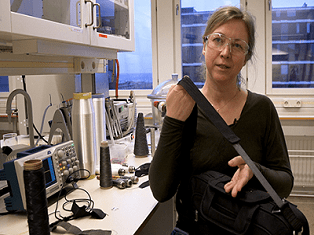In the 22 March edition of the Nature Partner journal of Flexible Electronics, a report was published that might just redefine our clothing of the future.
The Swedish School of Textiles and research institute, Swerea IVF, conducted studies on how electrostatic power can be generated from textiles. Researchers from Chalmers University of Technology put those studies to the test.
The researchers used what is known as a piezoelectric material. These are materials that generate an electric charge when put under mechanical stress. Cigarette lighters utilize Piezo ignition by slamming a hammer into a crystal that then ignites the gas. It also powers camping stoves, gas lights, and gas grills.
Engineers have envisioned, for some time, a world where piezoelectricity could power everyday items through kinetic energy.
 Source: Chalmers University of Technology
Source: Chalmers University of Technology
Researchers at Chalmers University of Technology have designed a fabric that converts kinetic energy into electric power using piezoelectric means. Using piezoelectric yarn the researches have designed a textile which carries an electric current when stretched (this applies the mechanical stress to the material).
One of the researchers, Anja Lund explains:
“The textile is flexible and soft and becomes even more efficient when moist or wet. To demonstrate the results from our research we use a piece of the textile in the shoulder strap of a bag. The heavier the weight packed in the bag and the more of the bag that consists of our fabric, the more electric power we obtain. When our bag is loaded with 3 kilos of books, we produce a continuous output of 4 µW. That’s enough to intermittently light an LED. By making an entire bag from our textile, we could get enough energy to transmit wireless signals.”
The researchers say the stretching of the textile has generated a charge that produces enough power to ‘light an LED, send wireless signals or drive small electric units such as a pocket calculator or a digital watch’. The only problem? The signals are intermittent.
Using a heavy bag with the piezoelectric textile fitted to the shoulder strap, the researchers demonstrated how they could power an LED. Lund believes that sensors can be ultimately powered by the textiles.
The textile works even better when it becomes wet and therefore heavier. It follows then that when exercising and sweating while wearing these textiles, they have the potential to power sensors and generate enough power to connect via Wi-Fi to an Internet of Things network (freely available around every corner in the future).
Works cited:
Electric textile lights a lamp when stretched. https://www.chalmers.se/en/departments/chem/news/Pages/Electric-textile.aspx
